Engineering Ethics: Historical Impact on Aboriginal Communities
VerifiedAdded on 2022/12/27
|9
|1735
|29
Essay
AI Summary
This essay examines the intersection of engineering ethics and the historical treatment of Aboriginal communities in Australia. It begins by providing context on the history of mistreatment and discrimination faced by indigenous Australians, including forced assimilation, land dispossession, and denial of basic rights. The essay then explores how these historical injustices impact ethical practices within engineering, emphasizing the importance of treating all members of society with respect and integrity, regardless of race or ethnicity. It discusses the ethical responsibilities of engineers to avoid perpetuating discrimination and to promote social justice. The essay also analyzes the influence of Aboriginal communities and their representative communication within the engineering field, highlighting the need for engineers to understand and address the unique challenges faced by these communities. Finally, the essay concludes with reflections on how the learning can be applied in the future, emphasizing the importance of incorporating these ethical considerations into government programs and decision-making processes at the societal level to promote health awareness and build confidence within Aboriginal communities.
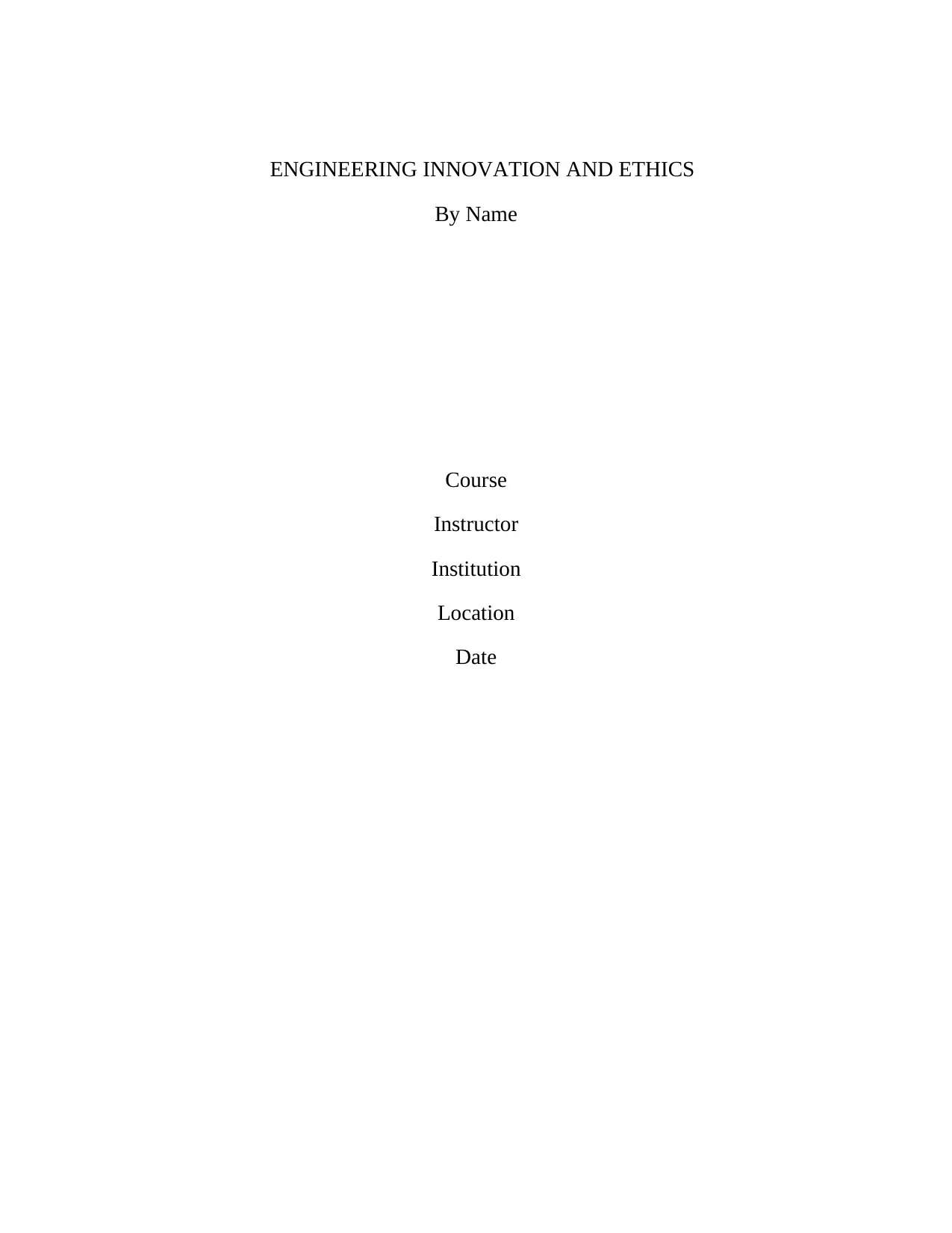
ENGINEERING INNOVATION AND ETHICS
By Name
Course
Instructor
Institution
Location
Date
By Name
Course
Instructor
Institution
Location
Date
Paraphrase This Document
Need a fresh take? Get an instant paraphrase of this document with our AI Paraphraser
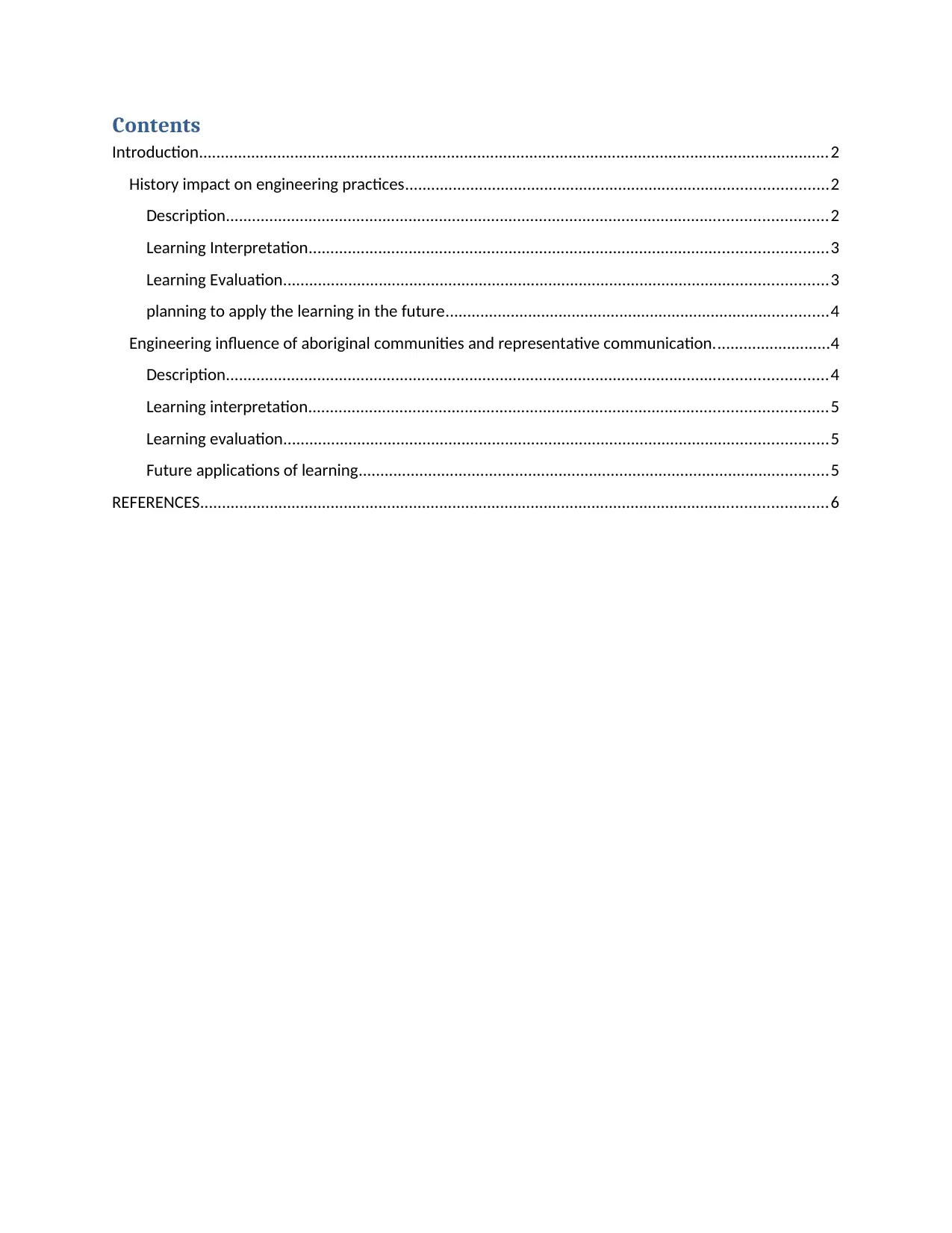
Contents
Introduction.................................................................................................................................................2
History impact on engineering practices.................................................................................................2
Description..........................................................................................................................................2
Learning Interpretation.......................................................................................................................3
Learning Evaluation.............................................................................................................................3
planning to apply the learning in the future........................................................................................4
Engineering influence of aboriginal communities and representative communication...........................4
Description..........................................................................................................................................4
Learning interpretation.......................................................................................................................5
Learning evaluation.............................................................................................................................5
Future applications of learning............................................................................................................5
REFERENCES................................................................................................................................................6
Introduction.................................................................................................................................................2
History impact on engineering practices.................................................................................................2
Description..........................................................................................................................................2
Learning Interpretation.......................................................................................................................3
Learning Evaluation.............................................................................................................................3
planning to apply the learning in the future........................................................................................4
Engineering influence of aboriginal communities and representative communication...........................4
Description..........................................................................................................................................4
Learning interpretation.......................................................................................................................5
Learning evaluation.............................................................................................................................5
Future applications of learning............................................................................................................5
REFERENCES................................................................................................................................................6

⊘ This is a preview!⊘
Do you want full access?
Subscribe today to unlock all pages.

Trusted by 1+ million students worldwide
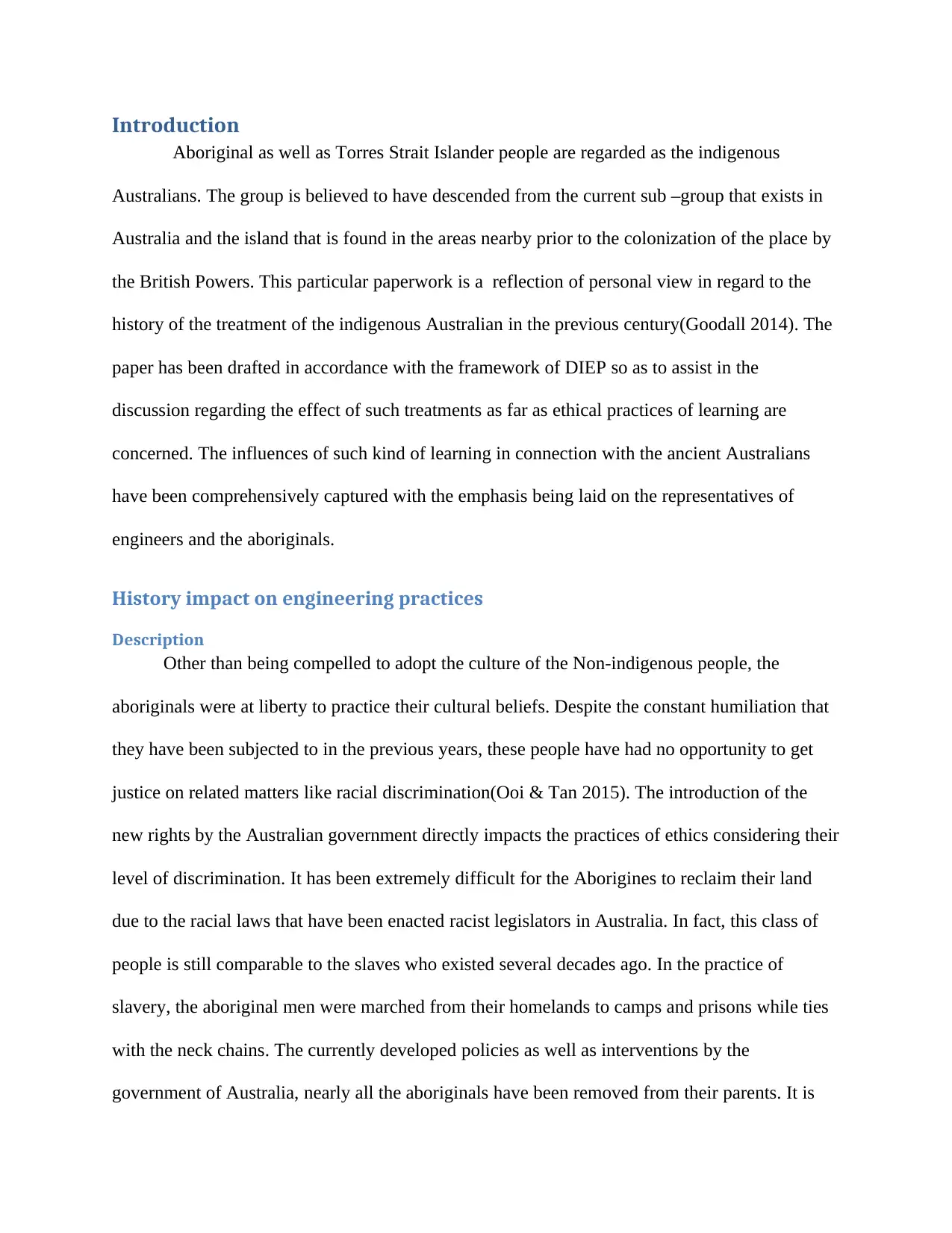
Introduction
Aboriginal as well as Torres Strait Islander people are regarded as the indigenous
Australians. The group is believed to have descended from the current sub –group that exists in
Australia and the island that is found in the areas nearby prior to the colonization of the place by
the British Powers. This particular paperwork is a reflection of personal view in regard to the
history of the treatment of the indigenous Australian in the previous century(Goodall 2014). The
paper has been drafted in accordance with the framework of DIEP so as to assist in the
discussion regarding the effect of such treatments as far as ethical practices of learning are
concerned. The influences of such kind of learning in connection with the ancient Australians
have been comprehensively captured with the emphasis being laid on the representatives of
engineers and the aboriginals.
History impact on engineering practices
Description
Other than being compelled to adopt the culture of the Non-indigenous people, the
aboriginals were at liberty to practice their cultural beliefs. Despite the constant humiliation that
they have been subjected to in the previous years, these people have had no opportunity to get
justice on related matters like racial discrimination(Ooi & Tan 2015). The introduction of the
new rights by the Australian government directly impacts the practices of ethics considering their
level of discrimination. It has been extremely difficult for the Aborigines to reclaim their land
due to the racial laws that have been enacted racist legislators in Australia. In fact, this class of
people is still comparable to the slaves who existed several decades ago. In the practice of
slavery, the aboriginal men were marched from their homelands to camps and prisons while ties
with the neck chains. The currently developed policies as well as interventions by the
government of Australia, nearly all the aboriginals have been removed from their parents. It is
Aboriginal as well as Torres Strait Islander people are regarded as the indigenous
Australians. The group is believed to have descended from the current sub –group that exists in
Australia and the island that is found in the areas nearby prior to the colonization of the place by
the British Powers. This particular paperwork is a reflection of personal view in regard to the
history of the treatment of the indigenous Australian in the previous century(Goodall 2014). The
paper has been drafted in accordance with the framework of DIEP so as to assist in the
discussion regarding the effect of such treatments as far as ethical practices of learning are
concerned. The influences of such kind of learning in connection with the ancient Australians
have been comprehensively captured with the emphasis being laid on the representatives of
engineers and the aboriginals.
History impact on engineering practices
Description
Other than being compelled to adopt the culture of the Non-indigenous people, the
aboriginals were at liberty to practice their cultural beliefs. Despite the constant humiliation that
they have been subjected to in the previous years, these people have had no opportunity to get
justice on related matters like racial discrimination(Ooi & Tan 2015). The introduction of the
new rights by the Australian government directly impacts the practices of ethics considering their
level of discrimination. It has been extremely difficult for the Aborigines to reclaim their land
due to the racial laws that have been enacted racist legislators in Australia. In fact, this class of
people is still comparable to the slaves who existed several decades ago. In the practice of
slavery, the aboriginal men were marched from their homelands to camps and prisons while ties
with the neck chains. The currently developed policies as well as interventions by the
government of Australia, nearly all the aboriginals have been removed from their parents. It is
Paraphrase This Document
Need a fresh take? Get an instant paraphrase of this document with our AI Paraphraser
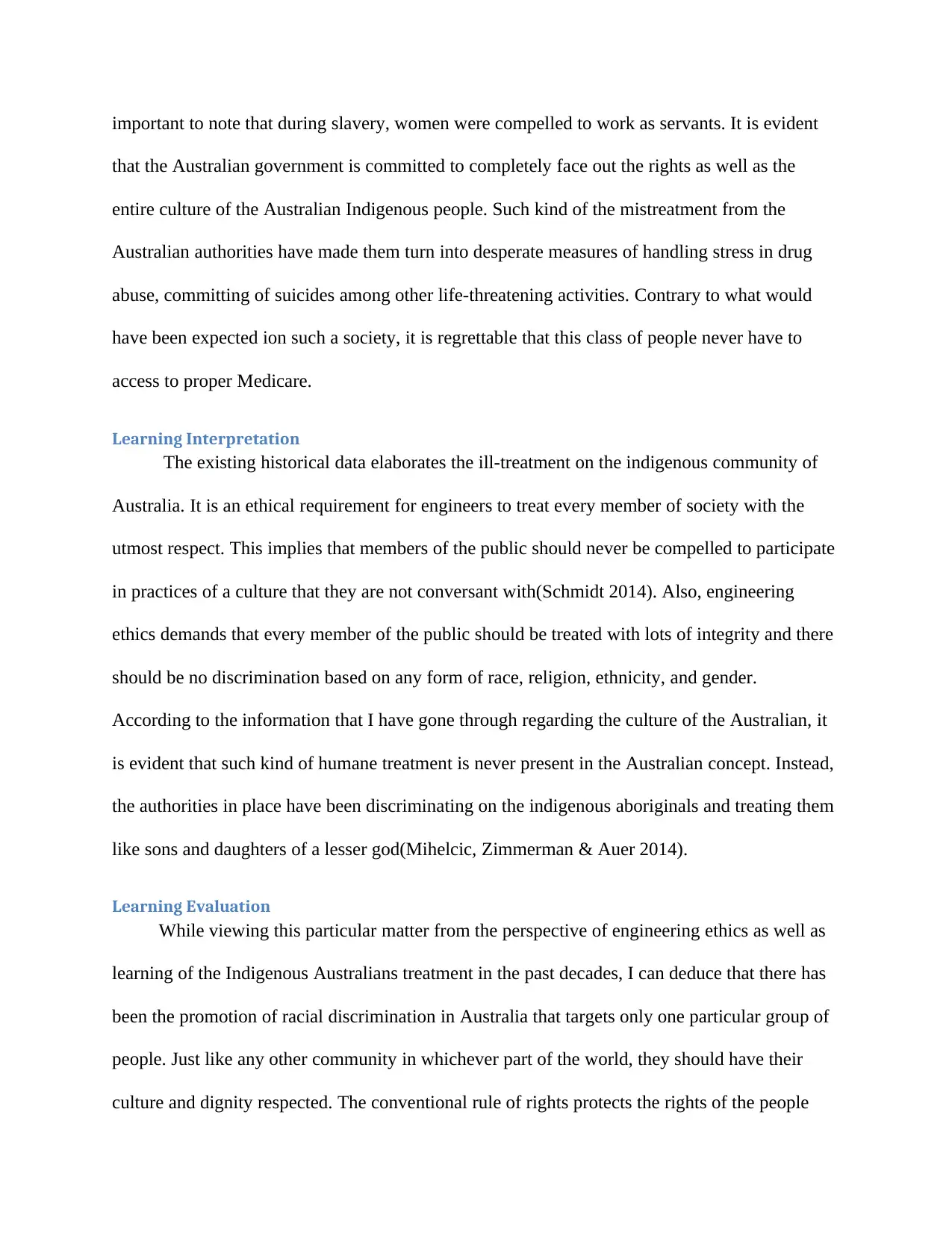
important to note that during slavery, women were compelled to work as servants. It is evident
that the Australian government is committed to completely face out the rights as well as the
entire culture of the Australian Indigenous people. Such kind of the mistreatment from the
Australian authorities have made them turn into desperate measures of handling stress in drug
abuse, committing of suicides among other life-threatening activities. Contrary to what would
have been expected ion such a society, it is regrettable that this class of people never have to
access to proper Medicare.
Learning Interpretation
The existing historical data elaborates the ill-treatment on the indigenous community of
Australia. It is an ethical requirement for engineers to treat every member of society with the
utmost respect. This implies that members of the public should never be compelled to participate
in practices of a culture that they are not conversant with(Schmidt 2014). Also, engineering
ethics demands that every member of the public should be treated with lots of integrity and there
should be no discrimination based on any form of race, religion, ethnicity, and gender.
According to the information that I have gone through regarding the culture of the Australian, it
is evident that such kind of humane treatment is never present in the Australian concept. Instead,
the authorities in place have been discriminating on the indigenous aboriginals and treating them
like sons and daughters of a lesser god(Mihelcic, Zimmerman & Auer 2014).
Learning Evaluation
While viewing this particular matter from the perspective of engineering ethics as well as
learning of the Indigenous Australians treatment in the past decades, I can deduce that there has
been the promotion of racial discrimination in Australia that targets only one particular group of
people. Just like any other community in whichever part of the world, they should have their
culture and dignity respected. The conventional rule of rights protects the rights of the people
that the Australian government is committed to completely face out the rights as well as the
entire culture of the Australian Indigenous people. Such kind of the mistreatment from the
Australian authorities have made them turn into desperate measures of handling stress in drug
abuse, committing of suicides among other life-threatening activities. Contrary to what would
have been expected ion such a society, it is regrettable that this class of people never have to
access to proper Medicare.
Learning Interpretation
The existing historical data elaborates the ill-treatment on the indigenous community of
Australia. It is an ethical requirement for engineers to treat every member of society with the
utmost respect. This implies that members of the public should never be compelled to participate
in practices of a culture that they are not conversant with(Schmidt 2014). Also, engineering
ethics demands that every member of the public should be treated with lots of integrity and there
should be no discrimination based on any form of race, religion, ethnicity, and gender.
According to the information that I have gone through regarding the culture of the Australian, it
is evident that such kind of humane treatment is never present in the Australian concept. Instead,
the authorities in place have been discriminating on the indigenous aboriginals and treating them
like sons and daughters of a lesser god(Mihelcic, Zimmerman & Auer 2014).
Learning Evaluation
While viewing this particular matter from the perspective of engineering ethics as well as
learning of the Indigenous Australians treatment in the past decades, I can deduce that there has
been the promotion of racial discrimination in Australia that targets only one particular group of
people. Just like any other community in whichever part of the world, they should have their
culture and dignity respected. The conventional rule of rights protects the rights of the people
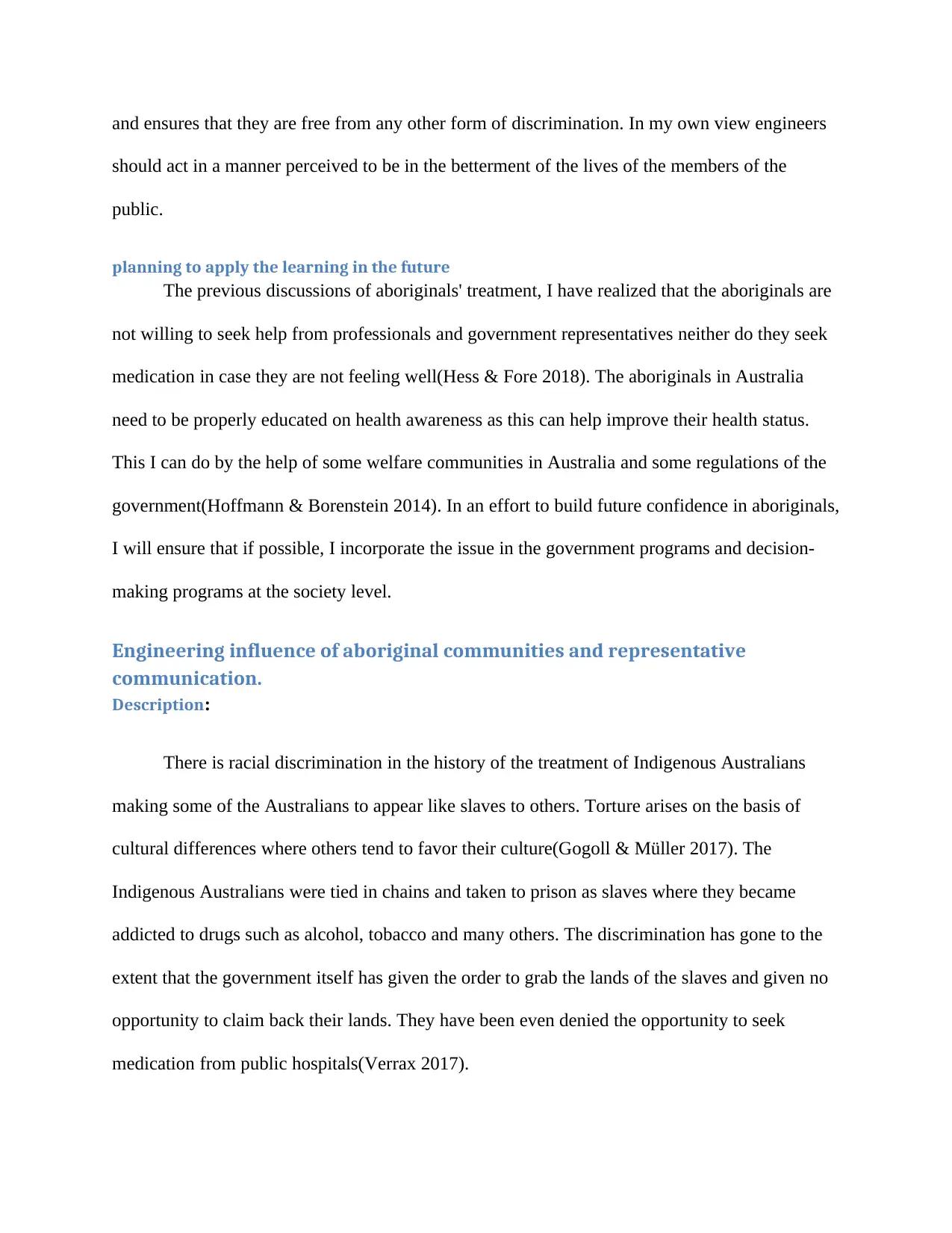
and ensures that they are free from any other form of discrimination. In my own view engineers
should act in a manner perceived to be in the betterment of the lives of the members of the
public.
planning to apply the learning in the future
The previous discussions of aboriginals' treatment, I have realized that the aboriginals are
not willing to seek help from professionals and government representatives neither do they seek
medication in case they are not feeling well(Hess & Fore 2018). The aboriginals in Australia
need to be properly educated on health awareness as this can help improve their health status.
This I can do by the help of some welfare communities in Australia and some regulations of the
government(Hoffmann & Borenstein 2014). In an effort to build future confidence in aboriginals,
I will ensure that if possible, I incorporate the issue in the government programs and decision-
making programs at the society level.
Engineering influence of aboriginal communities and representative
communication.
Description:
There is racial discrimination in the history of the treatment of Indigenous Australians
making some of the Australians to appear like slaves to others. Torture arises on the basis of
cultural differences where others tend to favor their culture(Gogoll & Müller 2017). The
Indigenous Australians were tied in chains and taken to prison as slaves where they became
addicted to drugs such as alcohol, tobacco and many others. The discrimination has gone to the
extent that the government itself has given the order to grab the lands of the slaves and given no
opportunity to claim back their lands. They have been even denied the opportunity to seek
medication from public hospitals(Verrax 2017).
should act in a manner perceived to be in the betterment of the lives of the members of the
public.
planning to apply the learning in the future
The previous discussions of aboriginals' treatment, I have realized that the aboriginals are
not willing to seek help from professionals and government representatives neither do they seek
medication in case they are not feeling well(Hess & Fore 2018). The aboriginals in Australia
need to be properly educated on health awareness as this can help improve their health status.
This I can do by the help of some welfare communities in Australia and some regulations of the
government(Hoffmann & Borenstein 2014). In an effort to build future confidence in aboriginals,
I will ensure that if possible, I incorporate the issue in the government programs and decision-
making programs at the society level.
Engineering influence of aboriginal communities and representative
communication.
Description:
There is racial discrimination in the history of the treatment of Indigenous Australians
making some of the Australians to appear like slaves to others. Torture arises on the basis of
cultural differences where others tend to favor their culture(Gogoll & Müller 2017). The
Indigenous Australians were tied in chains and taken to prison as slaves where they became
addicted to drugs such as alcohol, tobacco and many others. The discrimination has gone to the
extent that the government itself has given the order to grab the lands of the slaves and given no
opportunity to claim back their lands. They have been even denied the opportunity to seek
medication from public hospitals(Verrax 2017).
⊘ This is a preview!⊘
Do you want full access?
Subscribe today to unlock all pages.

Trusted by 1+ million students worldwide
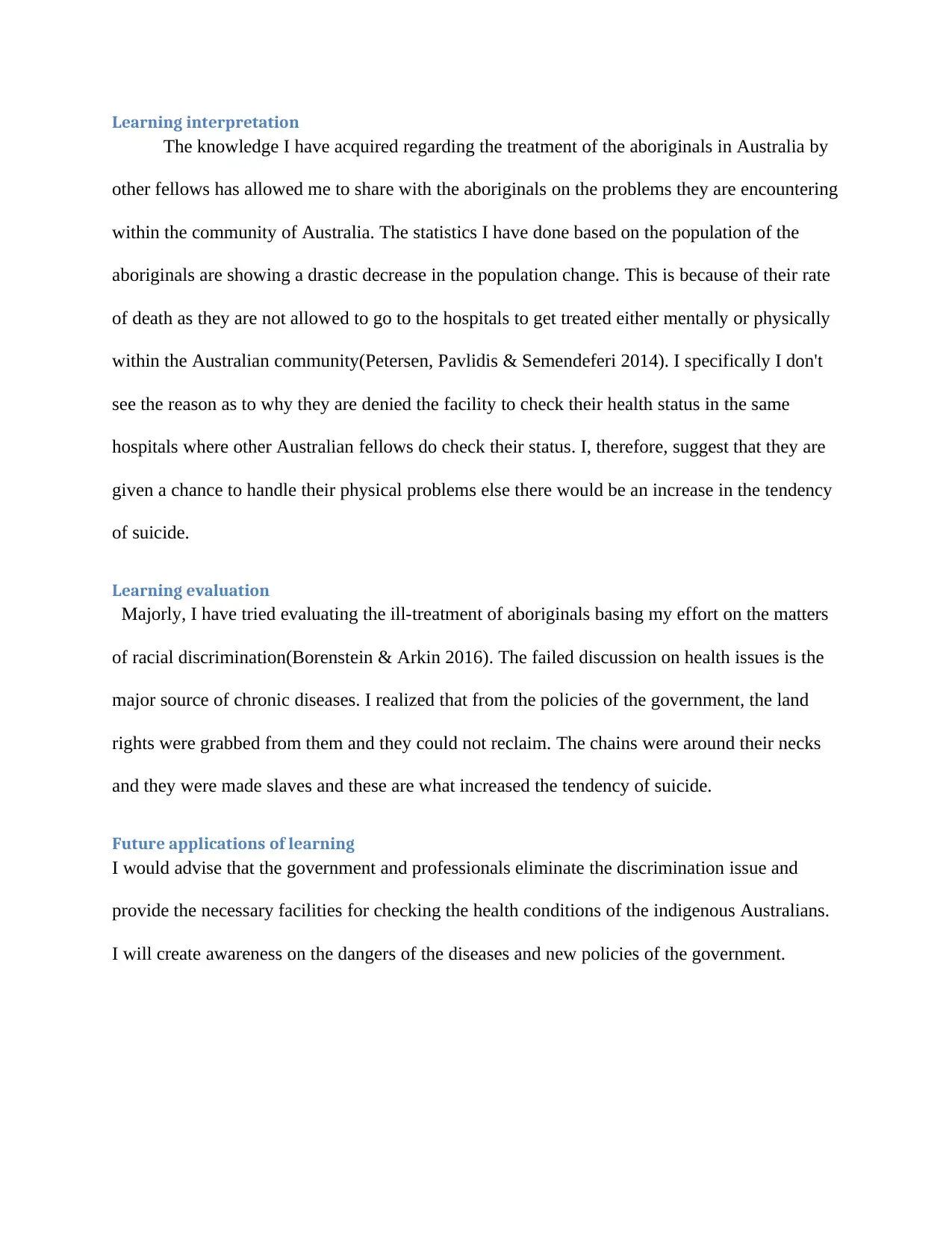
Learning interpretation
The knowledge I have acquired regarding the treatment of the aboriginals in Australia by
other fellows has allowed me to share with the aboriginals on the problems they are encountering
within the community of Australia. The statistics I have done based on the population of the
aboriginals are showing a drastic decrease in the population change. This is because of their rate
of death as they are not allowed to go to the hospitals to get treated either mentally or physically
within the Australian community(Petersen, Pavlidis & Semendeferi 2014). I specifically I don't
see the reason as to why they are denied the facility to check their health status in the same
hospitals where other Australian fellows do check their status. I, therefore, suggest that they are
given a chance to handle their physical problems else there would be an increase in the tendency
of suicide.
Learning evaluation
Majorly, I have tried evaluating the ill-treatment of aboriginals basing my effort on the matters
of racial discrimination(Borenstein & Arkin 2016). The failed discussion on health issues is the
major source of chronic diseases. I realized that from the policies of the government, the land
rights were grabbed from them and they could not reclaim. The chains were around their necks
and they were made slaves and these are what increased the tendency of suicide.
Future applications of learning
I would advise that the government and professionals eliminate the discrimination issue and
provide the necessary facilities for checking the health conditions of the indigenous Australians.
I will create awareness on the dangers of the diseases and new policies of the government.
The knowledge I have acquired regarding the treatment of the aboriginals in Australia by
other fellows has allowed me to share with the aboriginals on the problems they are encountering
within the community of Australia. The statistics I have done based on the population of the
aboriginals are showing a drastic decrease in the population change. This is because of their rate
of death as they are not allowed to go to the hospitals to get treated either mentally or physically
within the Australian community(Petersen, Pavlidis & Semendeferi 2014). I specifically I don't
see the reason as to why they are denied the facility to check their health status in the same
hospitals where other Australian fellows do check their status. I, therefore, suggest that they are
given a chance to handle their physical problems else there would be an increase in the tendency
of suicide.
Learning evaluation
Majorly, I have tried evaluating the ill-treatment of aboriginals basing my effort on the matters
of racial discrimination(Borenstein & Arkin 2016). The failed discussion on health issues is the
major source of chronic diseases. I realized that from the policies of the government, the land
rights were grabbed from them and they could not reclaim. The chains were around their necks
and they were made slaves and these are what increased the tendency of suicide.
Future applications of learning
I would advise that the government and professionals eliminate the discrimination issue and
provide the necessary facilities for checking the health conditions of the indigenous Australians.
I will create awareness on the dangers of the diseases and new policies of the government.
Paraphrase This Document
Need a fresh take? Get an instant paraphrase of this document with our AI Paraphraser
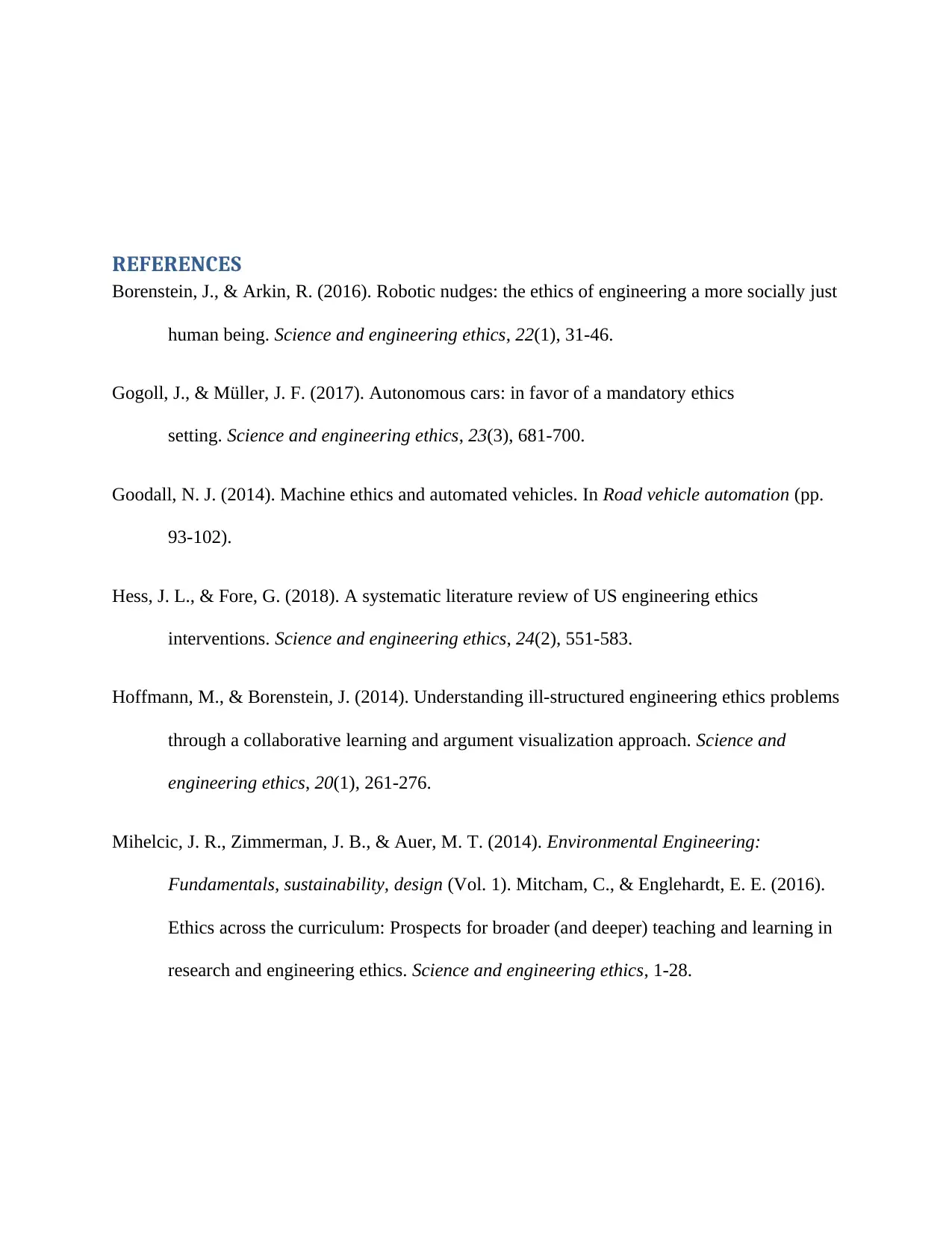
REFERENCES
Borenstein, J., & Arkin, R. (2016). Robotic nudges: the ethics of engineering a more socially just
human being. Science and engineering ethics, 22(1), 31-46.
Gogoll, J., & Müller, J. F. (2017). Autonomous cars: in favor of a mandatory ethics
setting. Science and engineering ethics, 23(3), 681-700.
Goodall, N. J. (2014). Machine ethics and automated vehicles. In Road vehicle automation (pp.
93-102).
Hess, J. L., & Fore, G. (2018). A systematic literature review of US engineering ethics
interventions. Science and engineering ethics, 24(2), 551-583.
Hoffmann, M., & Borenstein, J. (2014). Understanding ill-structured engineering ethics problems
through a collaborative learning and argument visualization approach. Science and
engineering ethics, 20(1), 261-276.
Mihelcic, J. R., Zimmerman, J. B., & Auer, M. T. (2014). Environmental Engineering:
Fundamentals, sustainability, design (Vol. 1). Mitcham, C., & Englehardt, E. E. (2016).
Ethics across the curriculum: Prospects for broader (and deeper) teaching and learning in
research and engineering ethics. Science and engineering ethics, 1-28.
Borenstein, J., & Arkin, R. (2016). Robotic nudges: the ethics of engineering a more socially just
human being. Science and engineering ethics, 22(1), 31-46.
Gogoll, J., & Müller, J. F. (2017). Autonomous cars: in favor of a mandatory ethics
setting. Science and engineering ethics, 23(3), 681-700.
Goodall, N. J. (2014). Machine ethics and automated vehicles. In Road vehicle automation (pp.
93-102).
Hess, J. L., & Fore, G. (2018). A systematic literature review of US engineering ethics
interventions. Science and engineering ethics, 24(2), 551-583.
Hoffmann, M., & Borenstein, J. (2014). Understanding ill-structured engineering ethics problems
through a collaborative learning and argument visualization approach. Science and
engineering ethics, 20(1), 261-276.
Mihelcic, J. R., Zimmerman, J. B., & Auer, M. T. (2014). Environmental Engineering:
Fundamentals, sustainability, design (Vol. 1). Mitcham, C., & Englehardt, E. E. (2016).
Ethics across the curriculum: Prospects for broader (and deeper) teaching and learning in
research and engineering ethics. Science and engineering ethics, 1-28.
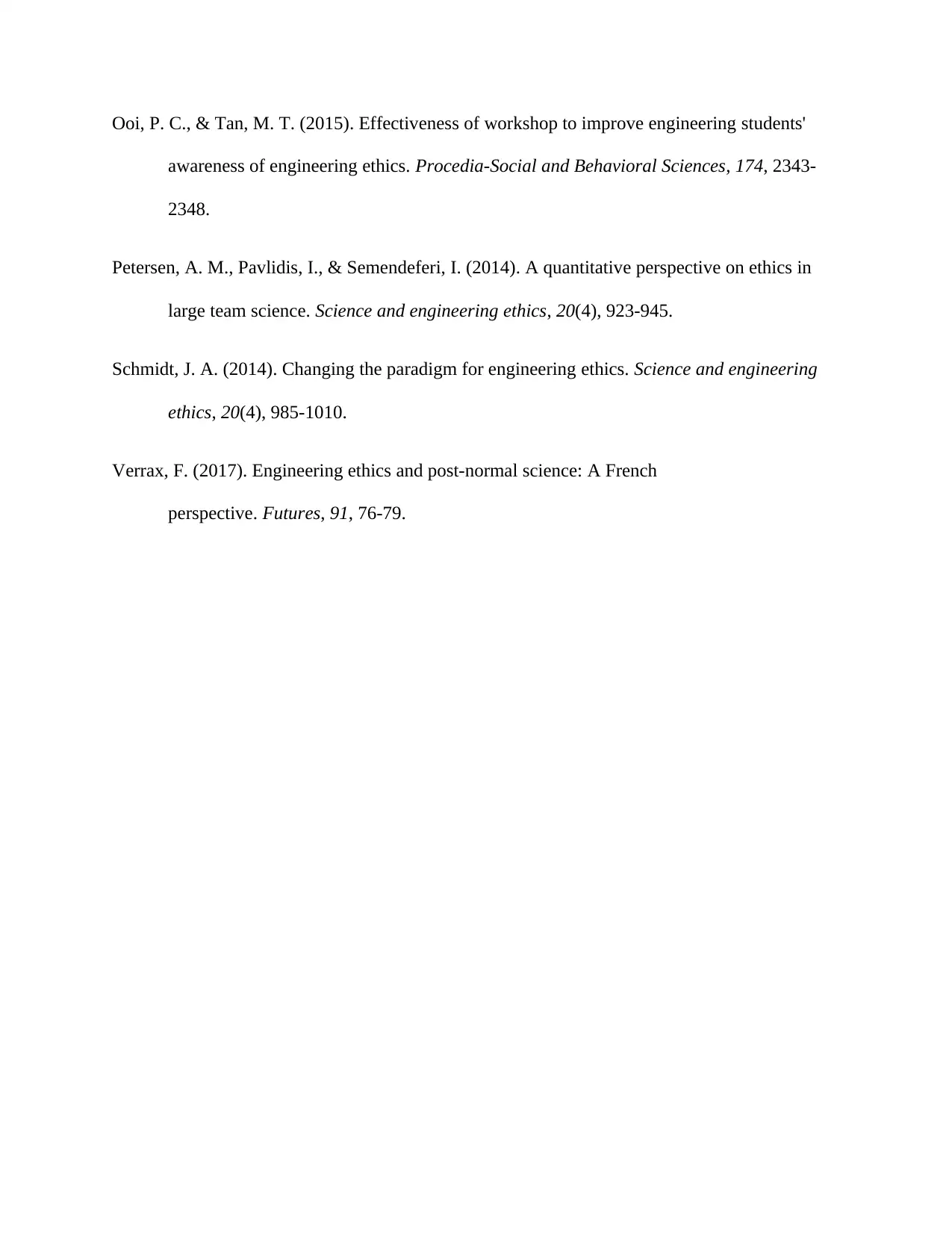
Ooi, P. C., & Tan, M. T. (2015). Effectiveness of workshop to improve engineering students'
awareness of engineering ethics. Procedia-Social and Behavioral Sciences, 174, 2343-
2348.
Petersen, A. M., Pavlidis, I., & Semendeferi, I. (2014). A quantitative perspective on ethics in
large team science. Science and engineering ethics, 20(4), 923-945.
Schmidt, J. A. (2014). Changing the paradigm for engineering ethics. Science and engineering
ethics, 20(4), 985-1010.
Verrax, F. (2017). Engineering ethics and post-normal science: A French
perspective. Futures, 91, 76-79.
awareness of engineering ethics. Procedia-Social and Behavioral Sciences, 174, 2343-
2348.
Petersen, A. M., Pavlidis, I., & Semendeferi, I. (2014). A quantitative perspective on ethics in
large team science. Science and engineering ethics, 20(4), 923-945.
Schmidt, J. A. (2014). Changing the paradigm for engineering ethics. Science and engineering
ethics, 20(4), 985-1010.
Verrax, F. (2017). Engineering ethics and post-normal science: A French
perspective. Futures, 91, 76-79.
⊘ This is a preview!⊘
Do you want full access?
Subscribe today to unlock all pages.

Trusted by 1+ million students worldwide
1 out of 9
Related Documents
Your All-in-One AI-Powered Toolkit for Academic Success.
+13062052269
info@desklib.com
Available 24*7 on WhatsApp / Email
![[object Object]](/_next/static/media/star-bottom.7253800d.svg)
Unlock your academic potential
Copyright © 2020–2025 A2Z Services. All Rights Reserved. Developed and managed by ZUCOL.





